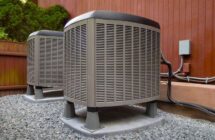FAQs
- Why should I purchase a new heating or air conditioning system?
- How can I find the system that’s right for me?
- Two Ton? Three Ton? What size system do I need?
- What about my ductwork?
- What is a heat pump?
- What happens when I replace my old system?
- How long will my system last?
- What can I do to control the humidity levels in my home?
- What can I do before calling Complete Heat & Air to service my system?
- What is SEER?
- What is AFUE?
- What is HSPF?
- What is R-22?
- What is R-410A?
- What is ENERGY STAR?
Why should I purchase a new heating or air conditioning system?
Purchasing a heating or air conditioning system is no small matter. However, if your existing system is old, in need of repair or simply inefficient, purchasing a new unit, one which can be as much as 40% more efficient than a system purchased just 10 years ago, can turn into a long term benefit. Rather than continuing to pay for ongoing maintenance and costly monthly bills, invest in a new system today that will save you money for years to come. To install the most efficient HVAC system in your household, a detailed inspection should first be performed by Complete Heat and Air. The inspection will include the inspection of your home’s ductwork, insulation, refrigerant piping, electrical service, wiring, thermostat, condensate piping, flue piping, flue terminations, filter, driers, registers, grills, drain pans and evaporator coil. We can then prepare a detailed estimate for you.
How can I find the system that’s right for me?
There are many heating and air conditioning systems to choose from today. By evaluating your home we can help you decide on the system that best fits your specific needs. The size and age of your home, as well as the number of rooms, climate, local and regional utility costs, degree days and utility incentive rebate programs are all factors that will affect the functionality and, therefore, selection of your system. Considering all these factors and, most importantly, your input while assisting you in choosing the best system for your home.
Consumers seeking to replace an existing system often choose a new unit with equal or higher efficiency ratings as compared to their previous system. Replacing a unit that is greater than 10 to 15 years old may reduce natural gas or electricity costs from 15 to 50%. Contacting Complete Heat and Air help you to define your initial cost, warranty protection, service options, maintenance options and operating cost. Once you have chosen a system it is important to remember that proper installation is a major factor in maximizing its operating efficiency and your comfort level.
Two Ton? Three Ton? What size system do I need?
Factors affecting the size of your new system include the climate in your area, humidity levels, the number of windows in your dwelling, total square footage of your home, the direction your home faces, the number of heat producing appliances in your home, the type of insulation you have and the number of people that live in your home. Complete Heat and Air can perform the proper calculations to determine the right size heating or cooling unit for your home and lifestyle.
What about my ductwork?
Ductwork is composed of two parts, supply and return. Supply duct is attached to the outflow of the new system, delivering air to each room in your home. The amount of air reaching each room is determined by the size of the supply ductwork connecting it to your system. The second part of the ductwork, the return duct, attaches to the inlet of the new system and draws air out of the spaces to be heated or cooled. Attached to the return duct is the filter. Ductwork can be either metal or flexible ducting and must be properly sized in order to evenly distribute the proper amount of air to each room.
What is a heat pump?
A heat pump is a device used for either the heating or cooling of a space by transferring hot and cold between two coils (similar to a cars radiator). A heat pump can act like an air conditioner, transferring heat from inside to out, or like a heater as it transfers exterior heat to the interior. A winter day with a temperature of 32° Fahrenheit still produces enough heat to warm a space when the air is transferred by a heat pump.
What happens when I replace my old system?
Once we have worked with you to chose the type of system, its capacity and other options, it’s time to begin the new installation. Complete Heat and Air will take care of all the details. Our installation technicians will arrive at your home with all the needed equipment and tools to do the job. Our technicians will introduce themselves, explain their process, cover your floors with drop clothes where needed and begin the replacement. Most replacements are finished in one day. Duct replacements usually take one to two days to complete. When the installation is finished you will be given a folder with all equipment manuals, your completed warranty registration and your invoice. Our goal is to leave your home better than we found it. Whether it’s crawl space clean-up, straightening your crawl space vapor barrier or vacuuming your floors, we want you to be pleased with everything we do.
How long will my system last?
Maintenance and service play a key role in the lifecycle of a heating or air conditioning system. If all recommended maintenance and service is performed as needed, it is believed that an air conditioner should last 15 years and a gas furnace should last from 18 to 20 years.
What can I do to control the humidity levels in my home?
Humidity levels can be reduced by operating a variable speed air handling system in your home. Variable speed units run longer, at lower speeds, allowing air to constantly circulate against the cooling coil and remove more moisture. Variable speed motors also use less electricity than regular motors, reducing your energy costs.
What can I do before calling Complete Heat and Air to service my system?
There are some things you can do before calling us to check your system:
- Make sure your circuit breakers are in the ON position. Turn breakers to the off position and back on to assure the breaker is on. Tripped breakers will sometimes stay in the ON position. TIP: Most HVAC equipment with use double pole breakers. In most brands of breakers this will be the widest breakers in your panel. Other items using double pole breakers are your range, water heater and clothes dryer.
- Make sure your filters are clean. If your unit is frozen up due to a dirty filter, call us and we can walk you through the thawing process. We can possibly save you the cost of a technician having to come to your home.
- Double check both indoor and outdoor disconnect switches. Sometimes there are electrical circuit breakers inside the grey or black boxes mounted beside your equipment. Switch these breakers OFF then back ON to be certain the breaker is not tripped. If there is not a breaker in your disconnect and only a pull out handle, we advise that it not be pulled unless there is an electrical problem with your unit.
- If your thermostat is digital and has gone blank, install new good quality batteries. Never use off brand batteries in your thermostat.
- Check the settings on your thermostat.
- Make sure the thermostat switch is on the appropriate COOL or HEAT setting and not in between the settings.
What is SEER?
SEER is the abbreviation for Seasonal Energy Efficiency Ratio. This term is used to rate the efficiency of air conditioning systems. An easy way to understand SEER ratings is to compare it to miles per gallon (MPG) in your car or truck. As MPG increases you use less gas. As your SEER rating increases your air conditioner uses less electricity. The standard SEER rating as of 2016 is 14 SEER. Systems are now available up to 19 SEER. However, in many instances the upfront cost of a high SEER system will be more than you can save over the 15 years life expectancy of your new system. Complete Heat and Air can show you the numbers to determine which SEER rating is the best investment for you.
What is AFUE?
AFUE is the abbreviation for Annual Fuel Utilization Efficiency ratio. AFUE is used to rate furnace efficiencies by dividing the ratio of heat output by heat input. This measurement describes how well fuel, gas or oil is consumed to produce heat by a furnace. As the AFUE rate increases, the efficiency of your furnace also increases, lowering your fuel costs. Furnaces manufactured in the United States are required to have at least an 80% AFUE. Most new furnaces we install are 95.5% efficient.
What is HSPF?
HSPF is the abbreviation for the Heating Seasonal Performance Factor. This factor rates the efficient operation of the heating portion of the heat pump. As the HSPF increases, the unit functions at a more efficient level.
What is R-22?
R-22 is the common name for hydro-chlorofluorocarbon (HCFC). R-22 has been used as a refrigerant by HVAC manufacturers for over 50 years, but studies in the past decade have shown that HCFCs contain chlorine, an ozone-depleting agent. For this reason, the United States Clean Air Act mandated that manufacturers cease production of HVAC equipment utilizing R-22 by January 1, 2010.
The production of R-22 has been drastically cut by the EPA. This has caused massive increases in the cost of new and recycled R-22. As the EPA’s deadline to cease production of any new R-22 approaches the cost will continue to drastically increase.
What is R-410A?
R-410A, a hydro-fluorocarbon (HFC) is the common name for the refrigerant being used in the HVAC industry today. R-410A is more environmentally friendly than R-22 and is the replacement for R-22 by HVAC manufacturers.
What is ENERGY STAR?
ENERGY STAR is a program that was created by the US Environmental Protection Agency (EPA) to help businesses and individuals make energy efficient purchases. This program places the ENERGY STAR label, a small blue and white logo, on items that meet superior energy efficiency standards. This label provides an easy way for consumers to identify quality, high efficiency products. For more information about the Energy Star program, please view their website at www.energystar.gov





